We recently received this email asking whether gemstone beads (especially from China) are fake, and it’s a great opportunity to address not only her question, but related questions that we frequently get over the phone and in our Showroom.
Hello,
I have recently come across some articles that say gemstones exported from China are fakes or contaminated. As a large distributor, do you test the products or suppliers before you re sell the items? If so, what are your findings? In general, do you think there is much truth to the speculation about gemstones and semi precious stones exported from China being fake or contaminated? Thank you for your help. –Lauren
Russ’ reply:
This is a great question. Thanks for giving me the opportunity to describe how we deal with misinformation and misleading names in the bead industry. We’ve struggled with this for years ever since I learned from a rockhound that most black onyx started out as chalcedony treated with sugar water and then heated.
The simple answer is yes, there is a lot of misrepresentation and misleading information about beads from China and elsewhere.
No, it’s not just beads from China that are enhanced or misrepresented. It’s not that simple. Enhancing or misrepresenting gemstones is not limited to Chinese suppliers.
Most buyers do not realize that gem enhancement is ancient, easily 2500 years old. Black onyx enhancement is reported in the notebooks of Pliny the Elder.
Some examples of treated or commonly misrepresented stones:
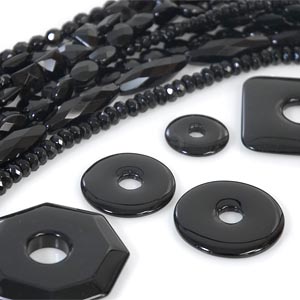
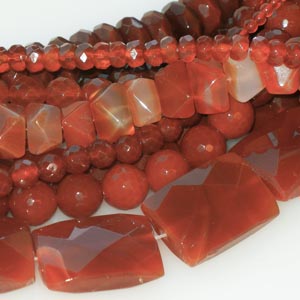
Most blue sapphires are heat-treated yellow sapphires, often by the miners.
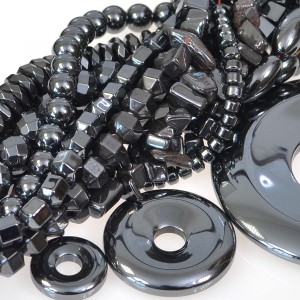
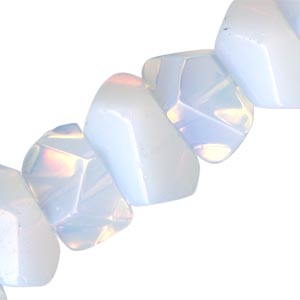
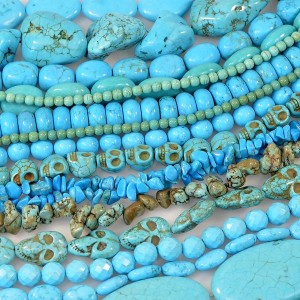
Most beads sold as “Chalk turquoise”, and too many beads on the market as “turquoise” or “stabilized turquoise” are really dyed magnesite.
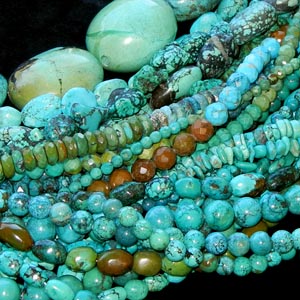
Although we are not gemologists at Rings & Things, and we don’t have fancy lab facilities or an X Ray Def machine in-house, we do use tried-and-true simple tests when we’re unsure about a batch of beads. When we receive unusually bright beads, or lovely even-colored beads strung on cord the exact same color, we put them in a bin of water for a few hours (or even weeks) to test if they are colorfast. We break occasional beads to see what color and/or texture is inside. We send out samples from metal suppliers for destructive assay to verify silver content and lack of lead or cadmium content. There is no equivalent testing facility for most gemstones sold as beads. The GIA (Gemological Institute of America) does a great job testing precious stones but they are not much help for inexpensive stone beads.
We ask a lot of questions from our suppliers. We research on the internet and ask others in the gem and bead industry. We track new stones names on the gem forums (particularly mindat.org.)
We make mistakes, but when we discover we’ve used the wrong description or name we quickly change to the correct one and admit our error.
Editor’s note: One example is Thunder Agate:
Our first batch of Thunder Agate was sold to us as Lake Superior Agate (the official gemstone of the state of Minnesota), but a customer in Minnesota told us “…it would be very hard to get any large Lake Superiors and the colors are not those of our area”. So we looked closer, and questioned the vendor, who said the rough is from the Thunder Bay area of Ontario (which is close, but not quite the same as the official stone). So we immediately re-tagged our beads, and sent a corrected email.
Part of the problem with beads from China is language and culture. Chinese names are often descriptive rather than technically mineralogical. The characters for turquoise in Chinese mean “Green tree stone.” Anything that looks like “Green tree stone” might be called turquoise.
Jade is very important in China but the word “Yu” for jade is used for many different stones that are used the way jade is used in China. Here is a quote that Barbara in Beadcollector.net wrote during her visit to Beijing Geological Museum:
‘Jade’ in China describes all polycrystalline and cryptocrystalline mineral aggregates and a few non-crystalline materials that are suitable for carving and making into jewellery. The characteristics are beauty, colour, moderate hardness, tough and fine texture, and as well as nephrite and jadeite includes opal, serpentine, quartz, turquoise, lapis lazuli, malachite, dushun yu, marble, natural glass, rhodocrosite, sodalite, and rhodonite.
You see the problem this causes? In the West, only jadeite and nephrite are really jade.
I agree that many stone beads coming from China are sold with inaccurate names or descriptions.
- Some misrepresentation is intentional because the fake will sell better if the buyer thinks is is a more expensive stone.
- Some is misunderstanding the level of mineralogical detail or accuracy we in the West want.
- Some is that the importer does not ask enough questions of the cutter or Chinese exporter and passes on inaccurate names.
- Some is mislabeling by the Chinese exporter because they do not understand the English words.
- Some is simply lack of knowledge about stones and not caring to find out what they are selling.
For example, a Chinese seller understands that dyed magnesite is not real turquoise and that “stabilized” means the stone is enhanced. This leads to a dealer with 2 piles of blue beads, one labeled “Stabilized Turquoise” and the other called “Natural Turquoise.” The stabilized pile was really blue dyed magnesite. The “natural” was real turquoise hardened with clear resin. Natural to us means that nothing has been done to enhance the stone. “Natural” to that dealer meant that it started out as real turquoise.
On Etsy and on Chinese sites I see blue dyed magnesite sold as dyed howlite. They tried to be accurate (and knew it wasn’t turquoise) but are using the wrong stone name.
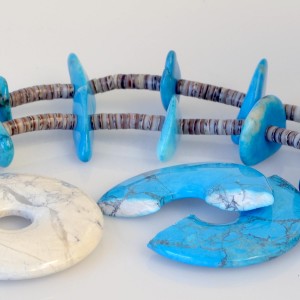
A lot of stones can be dyed or enhanced with stronger colors. Lately we’ve seen many common stones with intense colors added to them. Stones this intense should almost always be labeled as “dyed” or “enhanced”.
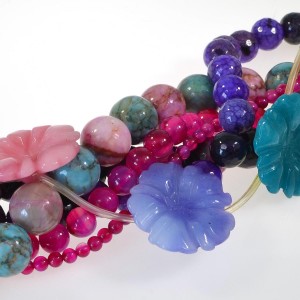
We try to accurately label enhanced and dyed stones. From our old printed catalog:
Some stones are simply dyed, which is not always colorfast. One way to avoid getting caught with stones that “run” when they are worn, is to look at the cord or plastic line the beads are strung on. If the cord is stained with blotches the same color as the beads, then beware. We avoid stones that look like they will “run”, so our altered beads are generally enhanced with various trade secrets such as the centuries-old methods for coloring black onyx and carnelian, or dyes that only come off when exposed to acetone or acid.
We label gemstone beads in our catalog and online store with the following symbols and terms:
+ enhanced,
* manmade, and
~ descriptive name.
There isn’t room on the tags for explanatory paragraphs, so on each stones Category page in our web store, we have more information about the stones. Scroll down below the Carnelian beads on this page for an example. To see all of this information in one place, you might also be interested in our Gemstone Beads Index (sorry, no longer in print – but almost all of the information from it, is in the headers and footers of our Gemstone Beads Categories in our online store, and we’re working on getting the remaining information live again); it has a great deal of information about each stone (where it is mined, and how to care for it, as well as common enhancements or other important information).+ Enhancements can include:
Dye/stain/acid to change the stone’s color or make natural color more pronounced or uniform.
Heat treatment to produce an effect such as crackling or color change.
Irradiation (harmless to the wearer) to create a new color.
Plastic/resin/wax to harden the exterior, making it more durable.~ Descriptive Name
The names for these beads are meant to describe what they look like, rather than identify what they are made of. These are generally accepted, common terms including “new jade” (a serpentine) and “African turquoise” (a jasper). They are genuine, natural gemstones that resemble more-expensive stones, and make excellent substitutes.
* Manmade
You’ll find that many online sellers, and nearly all of the “big box” stores don’t clearly label manmade gemstones. Goldstone, for example, has been made in Venice since the 17th century, but few end consumers are made aware this is a fancy glass rather than a gemstone grown by nature.
Stones carved from “block” should be called manmade, but many sellers call them “stabilized” or “reconstituted”, or don’t question them at all. Genuine malachite has become rare, very expensive, and nearly impossible to find as beads. Our manmade malachite is a nice imitation carved from block.
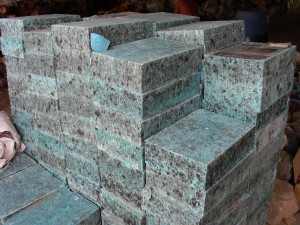
I’ve collected many pictures of fake and misrepresented turquoise on my Pinterest page to help educate buyers: http://www.pinterest.com/russnobbs/turquoise-imitations/
What can you do to avoid buying misnamed and misrepresented beads? Buy from dealers you trust and who can tell you about the material. Ask questions when you shop. Ask detailed questions. If you are uncomfortable with the answers or the prices, don’t buy. Do some of your own research by checking the information in our gemstone category pages, Gemstone Index, or other sites and lapidary books.
I hope this answered most of your questions. I appreciate your business and your questions.
—————————————-
Russ Nobbs, Founder & Director
http://www.rings-things.com – Spokane, WA – USA
Shop gemstone beads now:
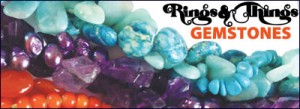
Additional questions can be posted at our Facebook page, or using the “Add a response” link below.
Links updated 2016-01-08. ~Polly Nobbs-LaRue. Russ, we miss you.
Edited December 2021to update links.

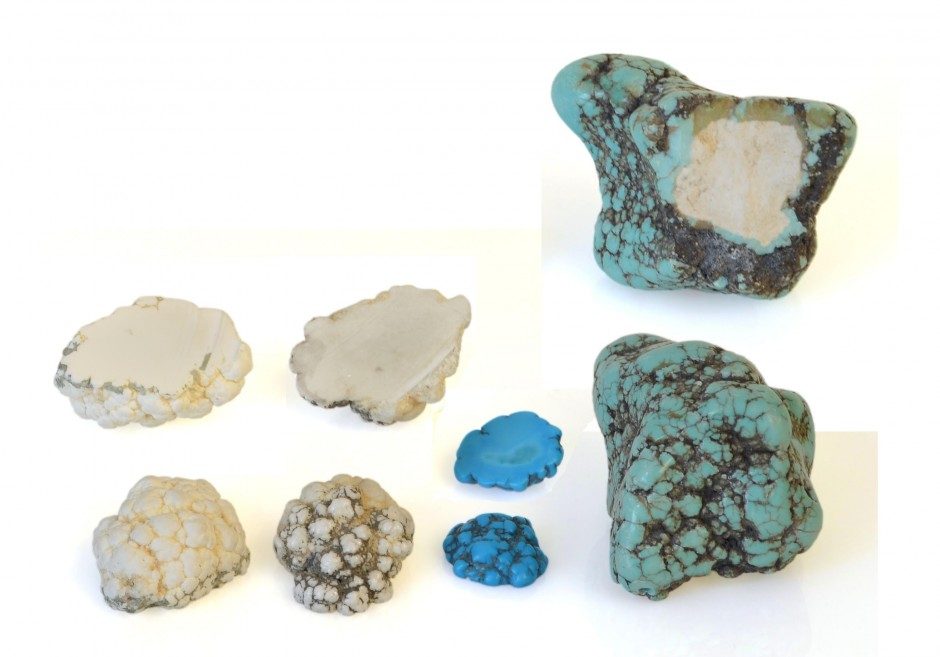
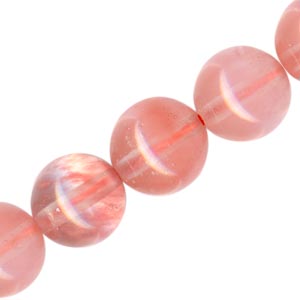
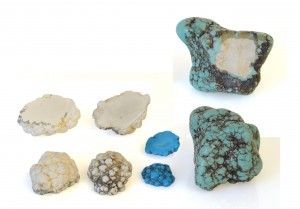

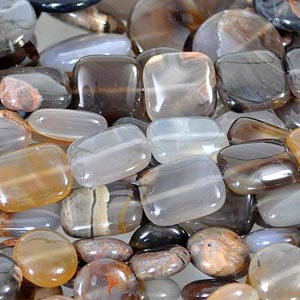
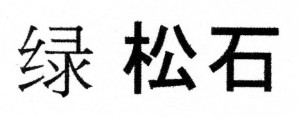

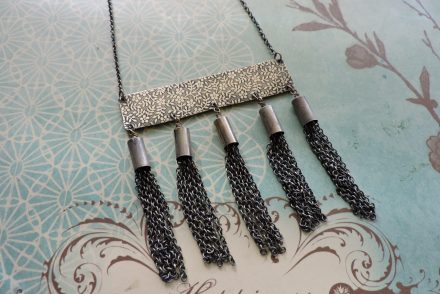
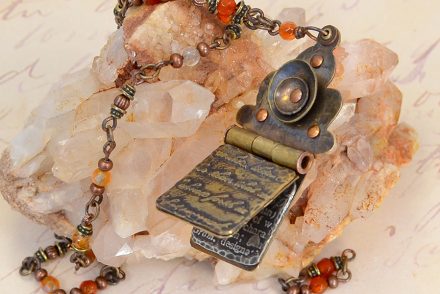
36 Comments
What a great and informative article. I loved learning some of the reasons behind the ‘fake’ stones.
And this is why I love you so much!!!! Keep the education going!!!!
Hi Tish! Great to hear from you. I love visiting your site — your color combos always make me happy. ~Polly
Thank you for teaching us what to look for. I used to go to a lot of gem and mineral shows. Due to covid 19, I’ve been reorganizing what I purchased in the last 30 years. I had forgotten how addicted I was back then and purchased many beautiful jaspers,agates and some man made and enhanced beads.
I have no regrets. It was fun.
I came across a strand of jet beads, ovals, that are smooth but feel waxy to the touch.
Shiny but not glassy shiny. How can I tell if these are really jet? Looking forward to your reply. Thanks again.
Do they feel WAY lighter than any other black gemstones you’ve handled? Jet is super light in weight. (But still glossy.) I hear it’s wonderful for doing inlay (but I personally have not branched out that direction). ~ Polly
Really wonderful article! One of my pet peeves is a vendor that doesn’t know what they are selling, especially at a bead show! Or worse, they lie about what they are selling. They never get my business. Thank you for taking the time to educate your readers/customers. This is just one of the qualities that sets you apart from the other bead vendors!
Thank you Kathleen. It’s one of my pet peeves, too and a reason I wrote the reply we turned into a blog post.
I’ve been asked for more details on how to tell the difference between magnesite and turquoise. I’ll give tips and examples in another blog post. I don’t have a good answer for the question about how to make your own “block imitation” turquoise. I did suggest a google search for “polymer clay faux turquoise” would find some small batch tutorials. Otherwise the commercial makers of “block” each have proprietary techniques and formulas that are not known to me.
Thank you for this great article Russ,
I will check the stones I have here.
I will check the given sites when I have doubts about certain stones in the future.
This was a very informative article. I have been buying cabs and beads for a while and was pretty lax about the type of material I was getting. I am pretty much all about the color! But recently I have been keeping track of my materials and trying to learn the stone and how to tell the good from the bad. This information was just what I need at this point. Thank you very much!
This is a very informative article, Russ! And one of the reasons that I do enjoy buying beads and stones from you! Enjoy the day. Erin
Good article! So what if you do buy dyed stones, soak them in water, and find that the dye is bleeding out? How do you get the dye that’s going to come off, off? Put them in a bag in the dishwasher? Just keep soaking until the runoff water is clear? I want to use these stones, but I don’t want to have a pink or green ring around my neck. Thanks!
Hi,
That can be a challenge. Different stones are treated in different ways. Some do come off in water. Because of this, we frequently soak “suspect” batches of stones in water to see if the color comes off that way. If it does, we’re sure to put a clear warning on the label! (And we don’t re-order them…). Others are fine in plain water, but start to come off on a hot day. They may have wax-based coloration. Others have color-fast enhancements that are not a problem.
Even if they fade over time, they don’t actually come off on your clothes or skin.
~Polly
Thank you for the wonderfully relevant information! I’m grateful to see efforts at honesty & transparency on all levels of jewelry design. Getting busted for misrepresenting your products, whether intentional or not, can shake or even destroy your reputation as a designer. Glad to see the place from which I purchase are looking out for me!
Thank you for the information. I have a question please. There are 3 sellers I recently asked question about their antique beads. These are their replies.
1. I inherited a relative’s bead collection. He traveled extensively, was passionate about collecting beads & I think he said the labels identifying beads were made by that relative. Note, most beads are on raffia & very cleam. Able see some inclusions and small chips on some of the beads.
2. Seller said they buy antique beads from sources in Germany. Note: In most of small groupings of beads, beads have dirt inside and outside.
3. Seller selling “antique mummy beads” says he has sold thousands of these beads, insists truly what advertising.
Personally, I tend to believe #1 because guy doesn’t claim to know anything about beads, but did know relative. Also, seller #2 sounds believeable. Third guy not so much, especially when I go ogled mummy beads & found article saying sales illegal & even if real to not support persons selling.
I know nothing about beads. On the one hand, since I don’t spend a lot of money, relatively speaking, I figure as long as I like them, it’s fine, but when I convince myself to bid a bit more, would like to think I am not being lied to. If beads are antique, does washing them or restringing them lessen their value? Starting to think it might be better to just pay more & buy from respected bead seller, like yourselves, than get caught up in the “deal” of bidding on ebay. Rather use ebay to buy what appeals to me & not consider any other factor, such as oh, wow, 200 or 2000 year old beads, oh my…
What do you think?
Apologies for the novel length question.
Hi Sherry,
I think you’re taking the right route — buying what you like, and doing research on your vendors.
#3) I agree with not buying those beads, whether they are real or not.
I believe that if you wash or restring beads that you want to display or re-sell as antiques, that it probably lessens their value, because it makes it harder to prove they are an antique. However, if you decide instead to make jewelry with them, you could increase the value — kind of like re-finishing a nice but beat-up old maple door as part of a new table or a new door with art glass or fold-formed copper set into it. Personally, I like to see old items turned into wearable or usable new art rather than collecting dust. But sometimes they are more beautiful they way they are, and deserve to proudly rest on a shelf (or a wall), dirt and old raffia and all.
–Polly
How would you tell if silver tone or sterling silver have lead in them? Is this common? I have bought beads from Panda Hall before, and now I’m wondering.
Trace amounts of lead in your earrings isn’t great, but also, trace amounts should not really be a problem. Where lead in jewelry is a big problem, is when a piece of jewelry is made with large quantities of lead, ANd children put it in their mouths. So as long as you don’t put the earrings in your mouth, and you keep them out of reach of children, all should be fine. Kids put lots of beads and necklaces in their mouths, the problems you’ve seen in court are when the kids have swallowed their beads. So it pays to be cautious, but your earrings should not be a danger to you. If you are very concerned, you can take your earrings in to someplace to have them tested. However, most of the tests involve some destruction, so if you like the earrings, you might not want to have them tested unless you bought extra pairs! ~Polly
Nice article 🙂 i recently ordered some black tourmaline from china and smoky quartz from japan and i have some doubts. There are no impurities at all in the smoky quartz, the beads are perfectly clear with no veins or cracks, the only natural seeming feature is the beads are slightly different shades from each other. It also magnifies text on paper I put behind it, is it supposed to be able to do that? . How you check the authenticity? Should i place my crystals in water like you said? What should the texture be like if i crack one open? Thank you 🙂
Hi James,
To me, it sounds like your smoky quartz might be lab-grown — especially if it seemed like a great price for the quality. If you research lab-grown quartz you’ll find some wonderful information on the internet — far more than I can fit in this article.
It’s basically identical to naturally-occurring quartz so there is no easy way to tell the difference, even if you shatter it.
Regarding the magnification, yes, it certainly can — but many clear stones (including glass) can magnify text if they are cut properly. (I haven’t studied this property to be able to provide any more useful information about it.)
–Polly
Hi, Polly,
Speaking as someone who’s had a class or two in optics — yes, basically anything that’s clear and solid (or liquid) can magnify text if it’s cut into an appropriate shape. A lot of cheap magnifying glasses are plastic, and work just fine. Water droplets can also be used to magnify things.
The interesting question is how much the text gets magnified. That depends on both the shape of the object and the “refractive index” (https://en.wikipedia.org/wiki/Refractive_index) of the material its made from. You could probably measure the refractive index of a clear object to get an idea about the material, much like measuring the density tells you something about it, but for something that’s a roughly-shaped bead rather than a precisely-cut lens or sheet, it’s hard to measure it very accurately.
For most non-precious gems or equivalent fake materials, though, this wouldn’t be that useful because they all have pretty much the same refractive index. The difference between plexiglas and polycarbonate, or the difference between plate glass and flint class, is bigger than the typical differences between plexiglas, plate glass, quartz, and rock salt. Things like diamonds have a high refractive index, but then so do the special optical plastics in my eyeglasses!
– Brooks
Hello. And what above the lava stones? I have heard that you can make a test with a hot water to decide whether your lava stone is real or fake. You should smell the concrete if the stone is fake (dyed concrete). I did this test on one of my lava stone beads, didn’t smell anything, but the bead is now more grey than black. Does it mean that it was dyed and it is fake?
Thanks for your answers 🙂
Hi Tootsie,
All lava stones that I’ve seen made into beads are waxed (or they would be very scratchy to wear). To get a nice glossy even smooth black, we have assumed the wax has a bit of color in it as well, and your results seem to confirm this.
Lava stones are fun to work with, with ACS and PMC, as once you burn off any impurities (such as the wax), they take a coating of the paste types very nicely and you can get an interesting porous-looking (but durable and lightweight) silver bead.
–Polly
Hello! What a surprise to read a great article from whom i consider a neighbor over in post falls! Do you have any local stores or any specific gem sellers that carry real lapis lazuli? Im hoping to get some earrings but i only want the real deal, no fakes or dyes. Any advice you would be willing to share on who to check out or buy from in our area?
Yikes, I’m sorry Amber – I thought I replied MONTHS ago, but I just ran across your post again and no reply visible.
We sell Lapis Lazuli… but not finished earrings.
Some of our lapis is dyed, and we label it as so. The other strands, we are pretty sure aren’t. But you’d have to make your own earrings … which is probably not what you want to do.
I would say that most of the higher end (and sterling silver / Wonders of the World types of) jewelry stores in our area have a good reputation. Check online (and the BBB) for reviews … people are pretty vocal nowadays about posting bad experiences. Then call to see if they have lapis earrings, since not every store does. Then as a final step, pick a time of day that a manager or multiple sales staff are likely to be working, so that when you go in, you’ll get access to more years of experience. Then when you ask about dyes and enhancement, you’ll get a well-rounded answer, rather than a junior sales clerk’s “No, of course they aren’t.” or “I have no idea … I don’t think you can dye stones.” — What you’re looking for a good clear “Why we know this particular pair is not dyed.” ~Polly
Great article, happy I decided to finally look further into wether my beads were real or not. Not happy to say because of this article the ones I’ve checked are not. I make jewelry which I sell, right now I am so disappointed. Perhaps investigating is good to do before buying. They are pretty but knowing they are not real is disappointing. How would you describe a stone to someone you’re trying to sell to?
Hi Jessie,
We have a few 100 examples of how I would describe them, here =) http://www.rings-things.com/Products/Gemstone-Beads-and-Pearls/
Basically:
* Shape,
* size,
* hole size (approximate),
* color + whether you believe it to be dyed or enhanced in any way, or whether stones LIKE it are commonly dyed or enhanced
* material (or what you believe the material is, or what it was sold to you as … or both!)
* quality / finish – does it have a high shine? is it matte? does it feel smooth or sticky or rough to your fingers?
~Polly
My husband and I have been buying gemstones since 2001. This is the best article I’ve seen on how to spot a fake and how to know what you are getting! Because we buy stones for their metaphysical properties, we are especially conscious of whether they are real, fake or glass/ceramic. Our daughter now makes bracelets and necklaces and sells them with affirmations and the metaphysical propreties listed. Again, very important to buy and sell what we want to represent as REAL! Thank you for this article!!! I will definitely share with our community!
Very good article, thanks. My company buys direct from Chinese factories and I can vouch that what they do (provide some stones that are highly un-natural) is what they think we want. Eg it’s pink and it’s stone and it’s pretty so it’s Rhodonite. You mean you wanted the ugly black-veined stuff? Your article has been a real help
Great blog !!!!!!!!!!
Awesome blog post , thanks!
That was great & understandable info.
Can you tell me anything about what treatment might be used when Welo Opals being stored properly turn a very unfortunate shade of yellow? I know resins can yellow, but this happened within 2 years of purchase and they weren’t stored in Sun or anything like that. Not all of my wellies turned though, so I know it’s a symptom of whatever treatment they do to these specific ones. I know they sugar Welos, but I don’t know if that would do it.
I’m devastated, I have several thousand in various stones for setting, strands of briolettes, rondelles, and rounds that are so ugly and such an unfortunate color of yellow that I wouldn’t want to make anything with them and certainly not to sell. They still have their fire and color play, but the whole stone where it use to be translucent, is now like, and this description is unfortunate, but I can’t think of anything else that nails it quite as well, but like urine from a dehydrated body.
I figured I didn’t have much to lose so I sealed some in with some silica packs just to see if anything g happened,, but no, nothing.
I know there are no black Welos and all are treated, but I wish now I had only bought black. Those still look the same. Some of my clear ones still look great though, I assume they were higher quality. I’ve read other jewellers say it’s happened to them and they’ve no clue why or what caused it, but there’s no reversing it. I know I’ll likely never buy another Welo again.
Hi Anita,
I did a little bit of quick research and it looks like there are a lot of theories bouncing around, but no sure reasons (too much moisture, not enough moisture, contaminants in the air/water, resin stabilization, etc.). My bet is poor quality resin… which is not likely to be fixable. Maybe do some more research on whether or not yellowed resin is fixable, and experiment on some of your less-expensive icky yellow opals.
I have no idea whether the resin is a layer on top (like old-fashioned triplets had a quartz layer on the top) or if the entire opal is saturated with resin, but I fear the latter, especially since some are beads rather than cabochons for setting.
I will admit that we have avoided buying opal beads because some of the opals being marketed to us felt (and sounded) like resin rather than opals (but were beautiful) and others were priced like man-made opals but were marketed as being genuine. At some point, we will probably add some pretty man-made opal beads and make sure that ours are clearly marked as such. But they will definitely not be the resin-style, as those just don’t feel right — they feel plasticy.
Thank you so much for your care and great service to us !
Can you tell me what these stone beads are ? https://shopgoodwill.com/item/133672739
They say natural stone – but no name. Maybe Onyx or obsidian ?
It’s hard to tell. The picture is so shiny it even looks like it might be hematite (which is usually an identical manmade version, often called hematine or hemalyke). I think that onyx or hematite are the most likely. But I wouldn’t rule out obsidian or even black tourmaline. ~Polly